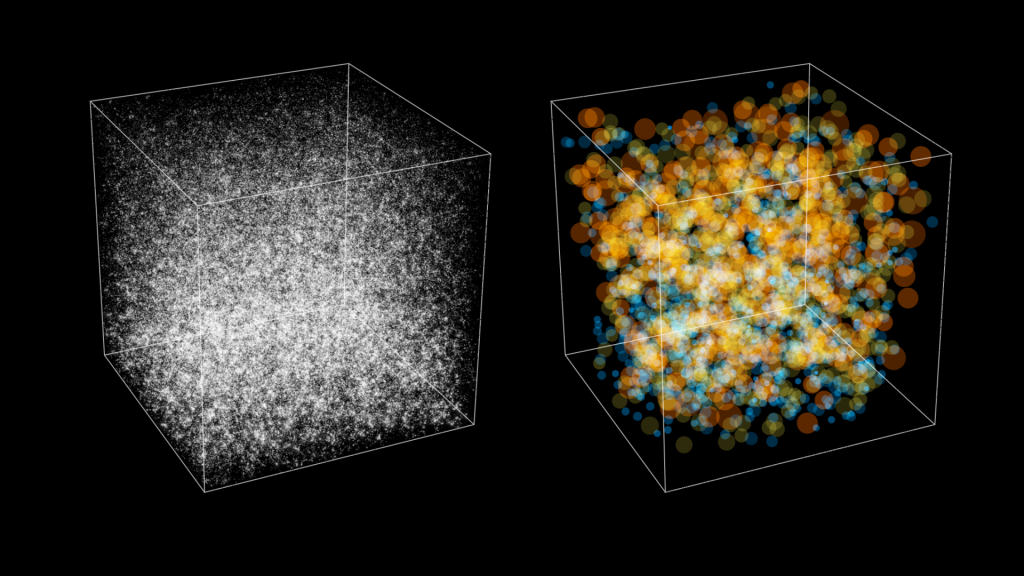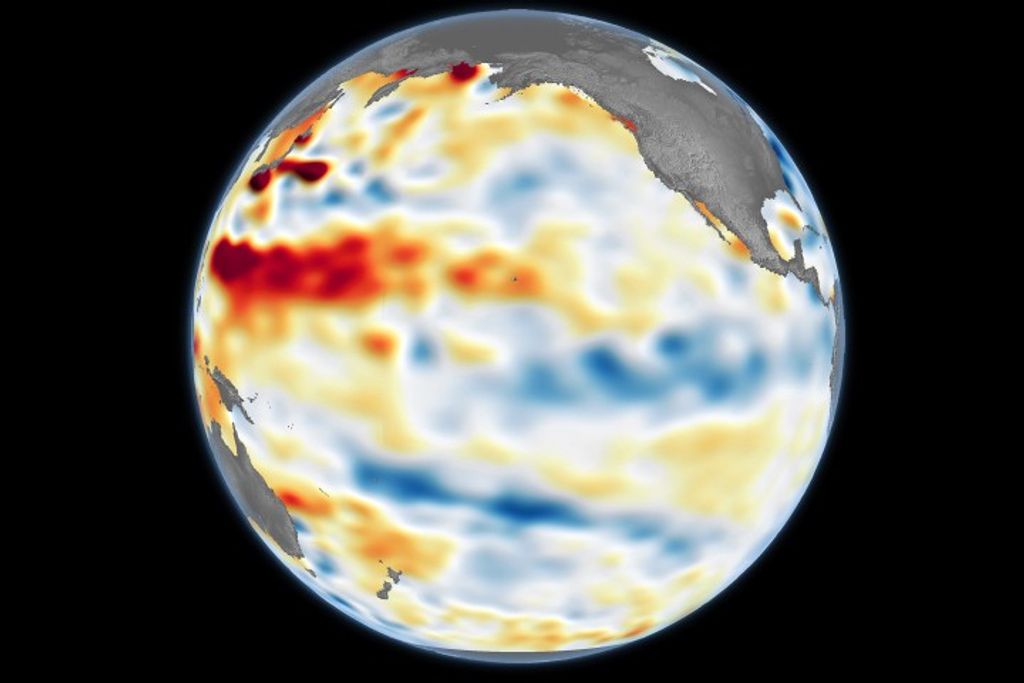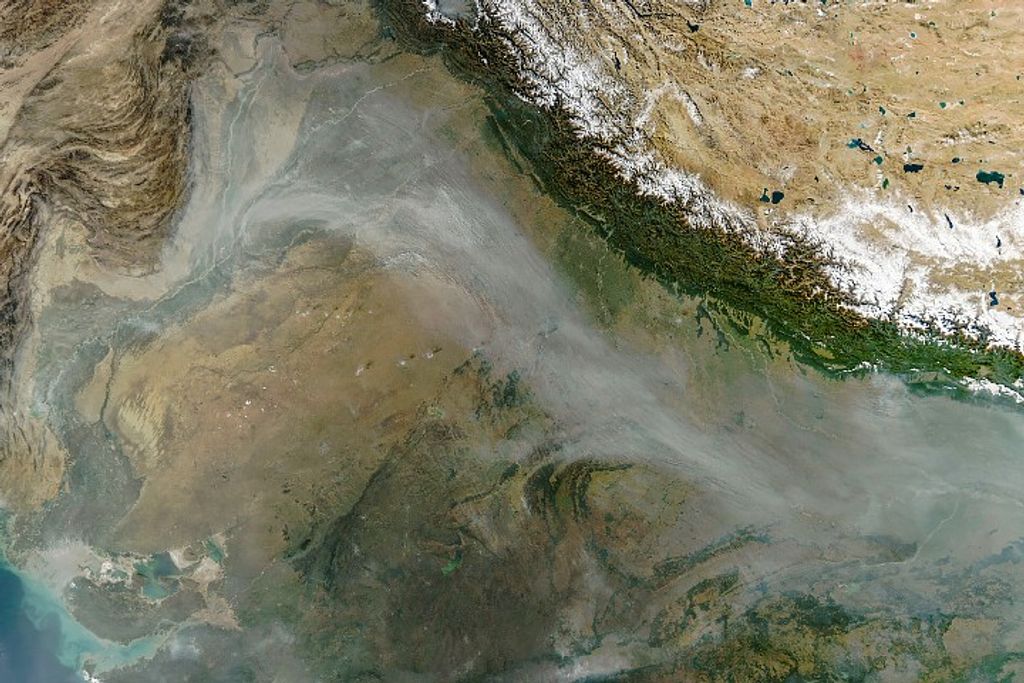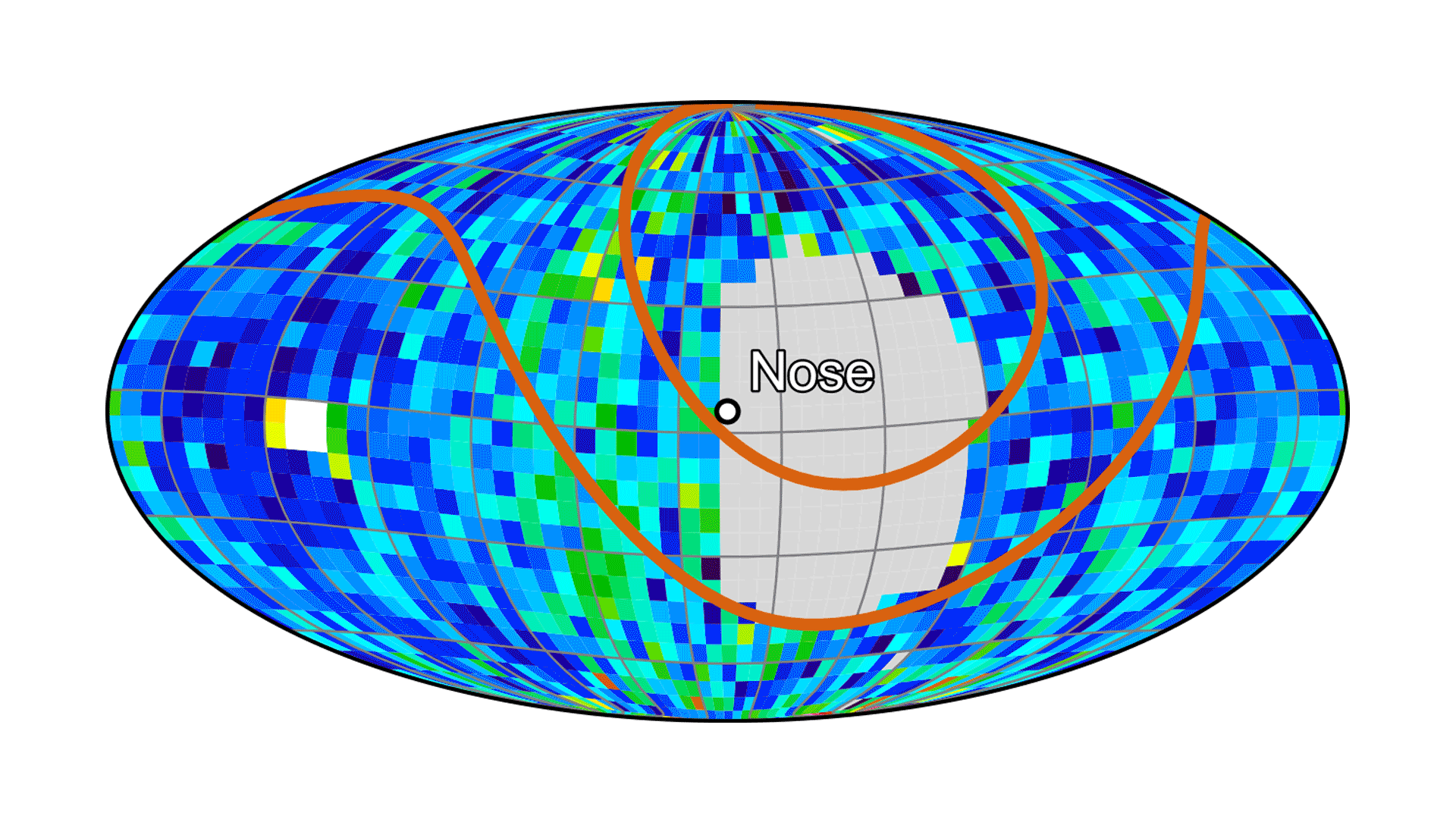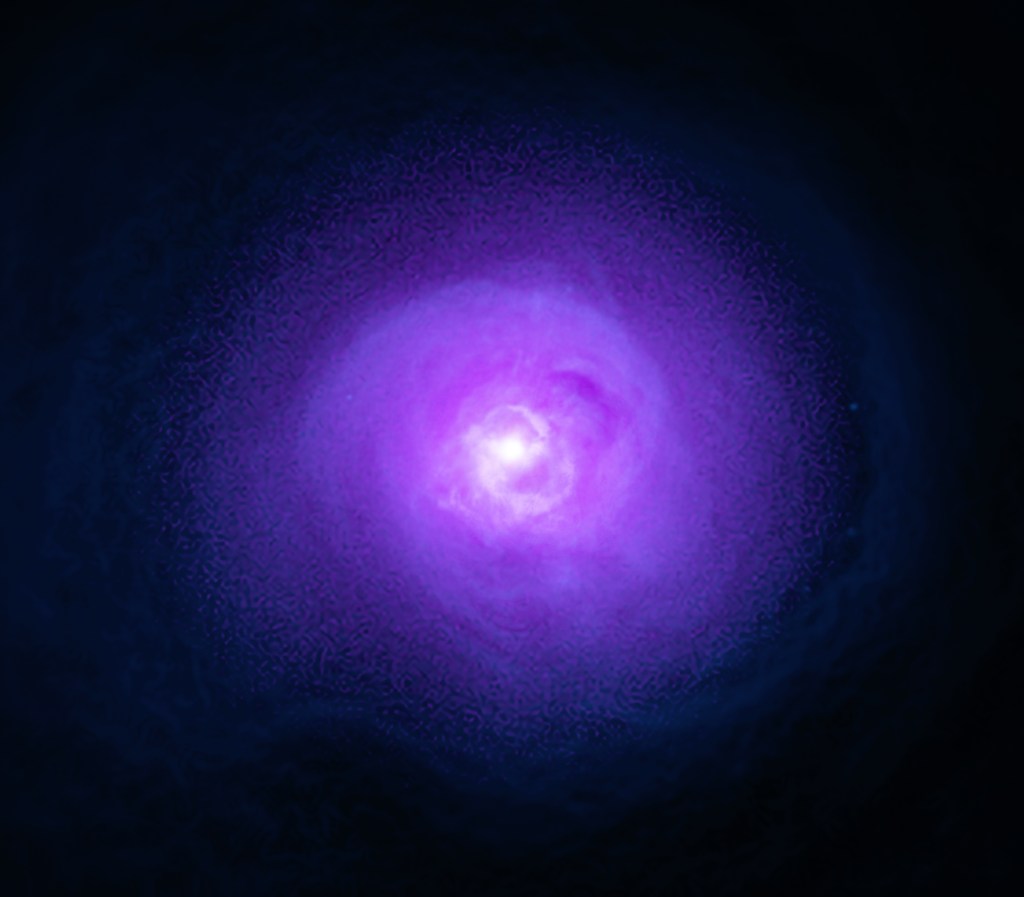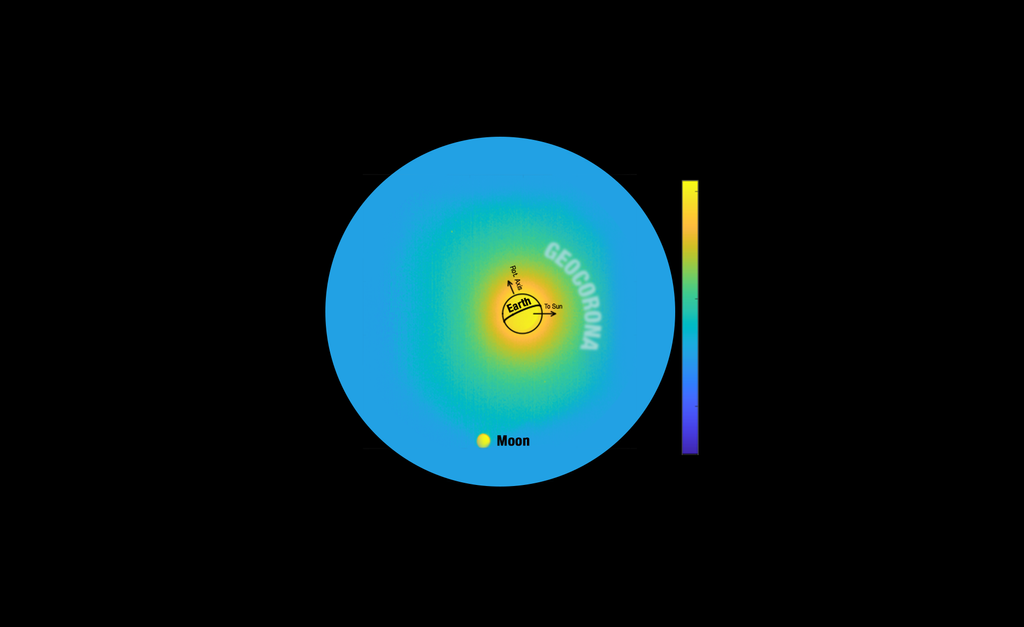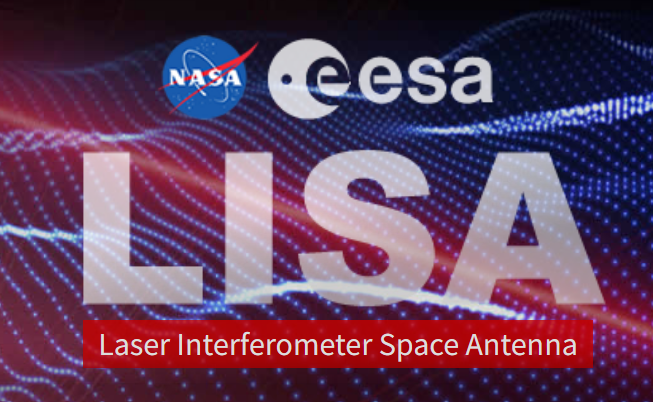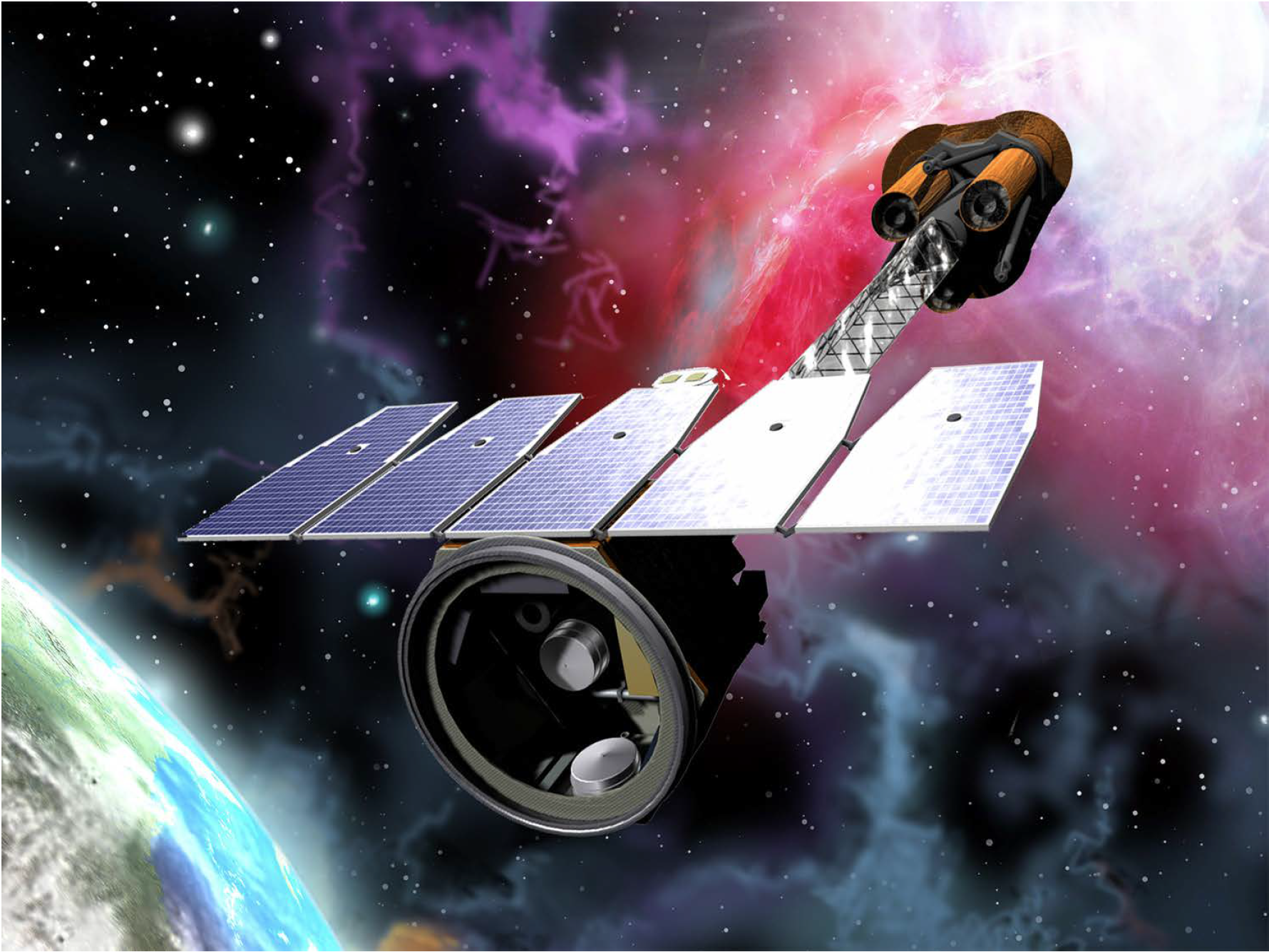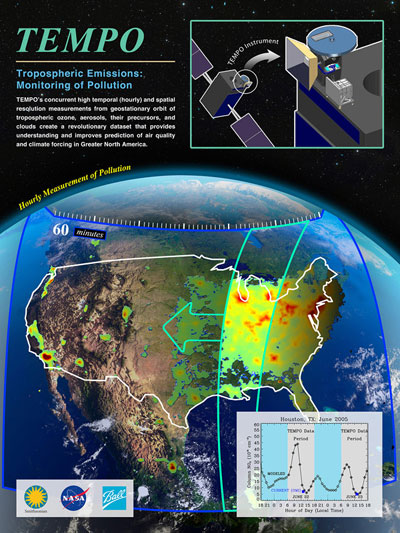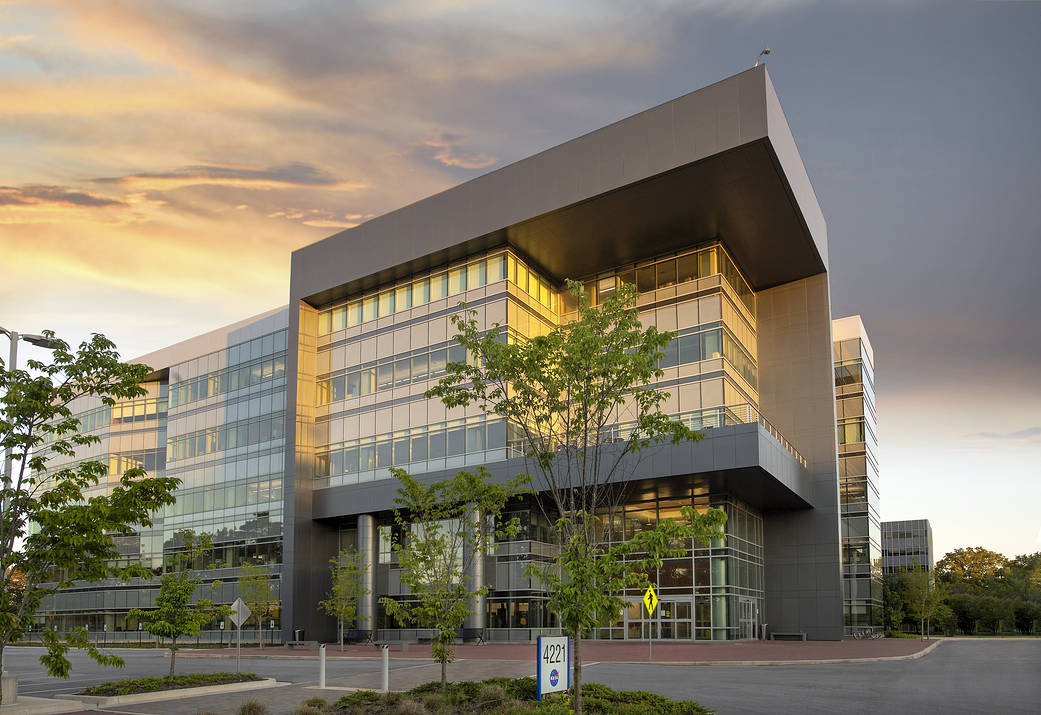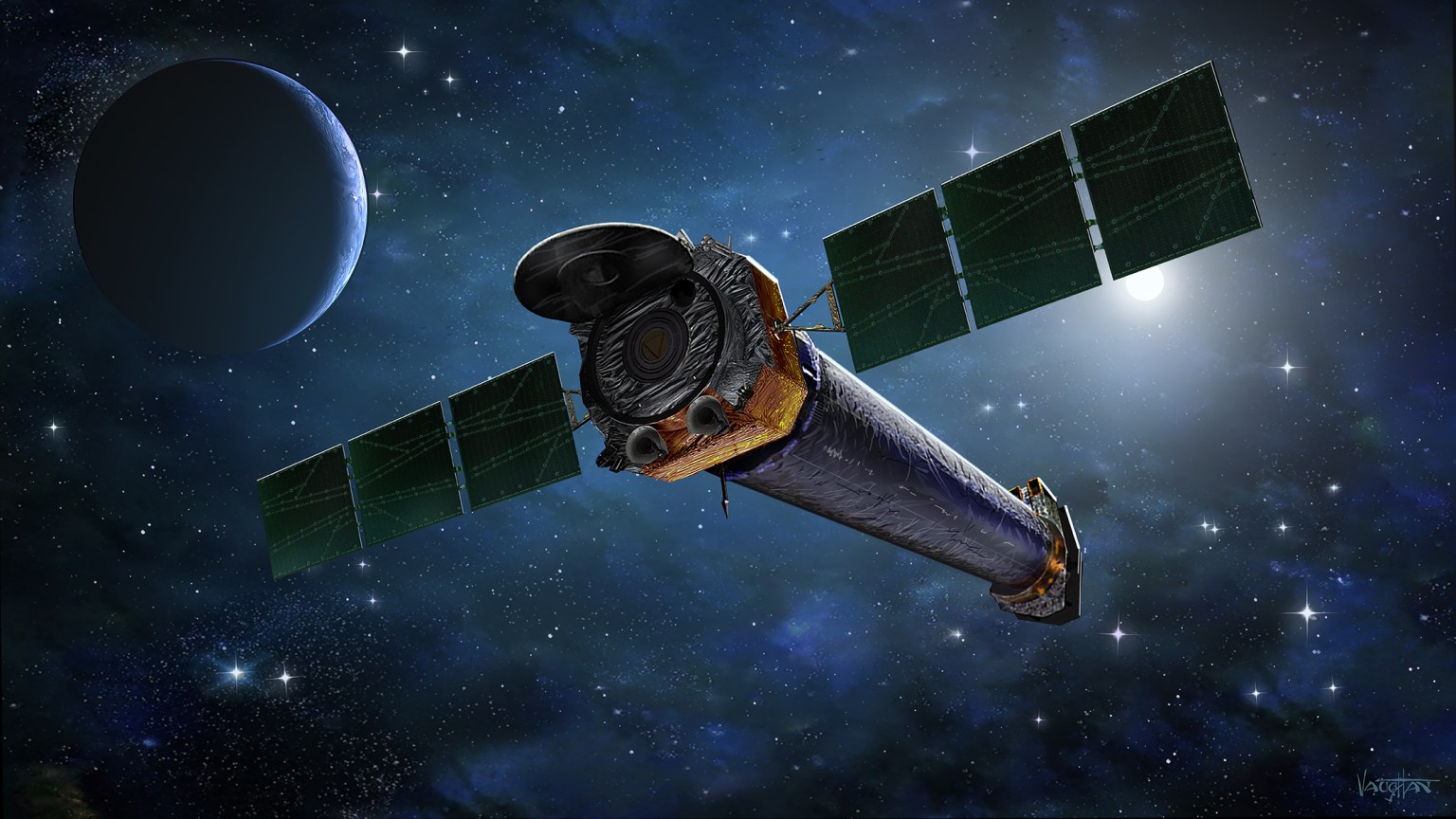Marshall Space Flight Center
Science Conferences and Collaborations 2025
Astrophysics
NASA Marshall Astrophysicists Join Meetings, Seminars in Japan
Marshall astrophysicist Jessica Gaskin recently visited JAXA (Japan Aerospace Exploration Agency)’s Institute of Space and Astronautical Science, the National Astronomical Observatory of Japan (NAOJ), and the Kavli Institute for the Physics and Mathematics of the Universe to teach a graduate class at the Graduate Institute for Advanced Studies at NAOJ, give seminar talks, and explore potential collaborations on the proposed High EneRgy Observatory for Imaging X-rays mission concept and similar Japanese-led hard X-ray missions. The proposed mission, anticipated as a Medium-Class Explorer proposal, aims to achieve an order-of-magnitude improvement in angular resolution compared to the current state-of-the-art hard X-ray observatory. This advancement could enable unprecedented insights into the physical processes driving extreme astrophysical environments such as supermassive blackhole growth. The Japanese-led CHRONOS (CHRomatic ON-call ObServatory, formerly known as JEDI) x-ray telescope mission concept was also discussed. NASA Marshall astrophysicists Nick Thomas, Steve Bongiorno and Chien-Ting Chen joined the meeting remotely.
LISA Data Analysis for All Workshop at the American Astronomical Society
Marshall astrophysics scientist Michael Katz led a two-day Laser Interferometer Space Antenna (LISA) workshop at the American Astronomical Society (AAS) prior to the start of the 245th meeting. The workshop was comprised of three major components: coding tutorials introducing the AAS community to LISA data analysis, scientific talks from LISA experts, and purposeful discussions on different types of difficulties people face along their career paths in Astronomy. Attendees provided positive feedback and have expressed the desire for Katz to conduct the same workshop next year, but with more people. At the AAS meeting itself, Katz gave a talk titled “The LISA Global Fit with LISA Analysis Tools” and worked multiple shifts at the LISA table within the larger NASA exhibit section.
Separate from the AAS meeting, Katz also gave a remote seminar to the Los Alamos National Laboratory on the Laser Interferometer Space Antenna (LISA). He presented a general introduction to LISA including its base instrumental components, astrophysical expectations, and science goals, and provided more detail about the LISA Global Fit and how it will be used to solve the difficult LISA data analysis problem.
IXPE Rossi Prize Plenary Talks Featured at the 245th Meeting of the American Astronomical Society
At the 245th Meeting of the American Astronomical Society (AAS), Martin Weisskopf, Emeritus within Marshall Space Flight Center’s Astrophysics Branch, and Paolo Soffitta of the Italian Space Agency gave plenary talks about the Bruno Rossi Prize that was awarded to them and the Imaging X-ray Polarimetry Explorer (IXPE) team by the High Energy Astrophysics Division (HEAD) of the AAS. Weisskopf and Soffitta recounted the many years of effort towards developing the technology for IXPE, producing a winning proposal, building IXPE, the impact of COVID, and the scientific successes with IXPE now operating on-orbit. Weisskopf wished the several hundred astronomers in attendance, “Tthank you and enjoy wrestling with the scientific implications.”
There were approximately 15 other presentations on IXPE and X-ray polarization at the meeting, with several from members of Marshall’s Astrophysics Branch, including Philip Kaaret who gave a talk on “Comparing the Accretion Geometries of Stellar and Supermassive Black Holes.” Marshall’s Peter Maksym presented a poster on “Mrk 421: 2 Weeks of Multi-Wavelength Monitoring with IXPE.” Oliver Roberts, also of Marshall’s Astrophysics Branch, presented a poster on “Revealing the magnetic field geometry of gamma-ray binary PSR B1259-63 via X-ray Polarimetry.” Marshall’s Chien-Ting Chen presented a poster on “IXPECALCARF: vignetting and aperture corrections for IXPE spectropolarimetric data analysis.” There was a strong IXPE presence at the Marshall Space Flight Center’s booth—organized by Astrophysics Communications Strategist Michael Allen—in the NASA exhibit area.
Physics of the Cosmos Program Analysis Group Hosts Splinter Sessions at the 245th Meeting of the American Astronomical Society
Chien-Ting Chen of Marshall Space Flight Center’s Astrophysics Branch co-organized the X-ray Science Interests Group (XRSIG) portion of the Physics of the Cosmos Program Analysis Group (PHYSPAG) sessions. The XRSIG session included presentations on X-ray mission updates by XRSIG members, one of which was on the Super-High Energy Replicated Optics mission by Nicholas Thomas of Marshall’s Astrophysics Branch. Chen also moderated the XRSIG open discussion during the session, which was well-attended with approximately 100 astronomers including other Astrophysics Branch participants and leadership team members from NASA SMD. During the discussion, the XRSIG community exchanged ideas to increase the community’s readiness for the upcoming astronomy decadal survey as well as actions for encouraging more early career scientists to enter the field of X-ray astronomy and instrumentation.
Marshall Astrophysicist Presents Overview of NASA’s New Astrophysics Cross Observatory Science Support Initiative
Daniel Kocevski of Marshall Space Flight Center’s Astrophysics Branch gave an overview presentation on NASA’s new Astrophysics Cross Observatory Science Support (ACROSS) initiative at the 245th meeting of the American Astronomical Society on Jan. 12, 2025. The ACROSS initiative, managed through the Physics of the Cosmos Office at Goddard, is tasked with enabling effective time-domain and multimessenger science by providing fleet-wide infrastructure and coordination of NASA’s space-based observatories. Kocevski serves alongside Marshall Astrophysicist Michelle Hui as Marshall subject matter experts in the ACROSS effort.
Relativistic Astrophysics Team Activities at the 245th American Astronomical Society Meeting
Members of the Relativistic Astrophysics team in Marshall Space Flight Center’s Astrophysics Branch participated in the 245th American Astronomical Society (AAS) Meeting Jan.12-16, 2025. Sarah Dalessi presented a talk entitled “A Fermi-GBM Search for Coincident Gamma-ray Emission from LVK O4 events.” Cori Fletcher chaired the Gamma-ray Bursts I session, volunteered as a Chambliss student poster judge, and presented a poster entitled “A Fermi-GBM Subthreshold Search Optimized for Magnetars.” Adam Goldstein presented a talk titled “The Gamma-Ray Data Tools: An open-source analysis toolkit for space based hard X-ray and Gamma-ray instruments,” advertising our team’s work funded by the Internal Scientist Funding Model (ISFM), and a poster titled “The Portal to the Universe: A Prototype Time-Domain and Multi-messenger Astrophysics Data Archive and Clearinghouse.”
Dan Kocevski presented a talk titled “Astrophysics Cross Observatory Science Support: Enabling Time-Domain and Multimessenger Astronomy.” Sarah Dalessi, Cori Fletcher, Michelle Hui, and Colleen Wilson-Hodge all volunteered at the Fermi booth. Colleen Wilson-Hodge participated in meetings of the High Energy Astrophysics Division Executive Committee as Vice-chair and participated in discussions about future possible Medium Explorer proposals.
LISA Data Analysis Presented to the LISA Early Career Scientists Group
Michael Katz of Marshall Space Flight Center’s Astrophysics Branch was invited to give a seminar for the Laser Interferometer Space Antenna (LISA) Early Career Scientists group for an introduction to LISA Data Analysis and Global Fit. Katz spoke to a group of roughly 30 early career scientists eager to learn about the status of LISA work in the data analysis area. He detailed the status of the overall large-scale global fit pipelines and presented status updates, resource information, and future work opportunities for each of the individual source classes (e.g., massive black hole binaries, galactic binaries, etc.).
Introduction to the “Laser Interferometer Space Antenna (LISA) Data Analysis” Seminar Presentations for the LISA Early Career Scientists Group
Michael Katz (Astrophysics Branch) was invited to give a seminar for the Laser Interferometer Space Antenna (LISA) Early Career Scientists group for an introduction to LISA Data Analysis and Global Fit. Katz spoke to a group of roughly 30 early career scientists eager to learn about the status of LISA work in the data analysis area. He detailed the status of the overall large-scale global fit pipelines, as well as giving status updates, resource information, and future work opportunities for each of the individual source classes (e.g., massive black hole binaries, galactic binaries, etc.).
Earth Science
Marshall Team Contributes to Successful 2025 NASA Disasters Science Team Meeting
Multiple Marshall team members attended and presented at the 2025 NASA Disasters Program Science Team Meeting in Boston on June 13, 2025. Earth scientist Ronan Lucey gave a presentation overviewing the Disasters Partnership and Learning program element and facilitated an interactive exercise soliciting feedback on the future directions of the NASA Disasters Mapping Portal. Earth scientist Jordan Bell presented on updates related to NASA’s Commercial Satellite Data Acquisition Program, while Earth scientist Alex Melancon presented on Landsat and Sentinel data acquisition and processing techniques. NASA postdoctoral fellow and Earth scientist Hannah Pankratz represented multiple SAR research activities at the meeting, including work on SAR Foundation Models as well as Debris estimation. Marshall Earth scientist Brent Roberts facilitated a panel of Disasters Program science team members discussing their plans for their research funded by the program. The MSFC team’s presentations and contributions to the meeting were well received, with all team members actively engaging with scientists, center response coordinators, and end users throughout the meeting.
Keynote at the International Conference on Machine Learning (ICML) 2025 Terrabytes Workshop
Sujit Roy, lead AI researcher at the Office of Data Science and Informatics at Marshall, gave a keynote presentation at the International Conference on Machine Learning 2025 in Vancouver, Canada. The presentation was part of the Terrabytes Workshop, which brought together researchers working at the intersection of machine learning and geospatial data. Roy’s talk covered research opportunities, challenges, and lessons learned in advancing foundation model development for science applications, contributing to the workshop’s mission of scaling machine learning for real-world geospatial problems.
Marshall at the NASA Biological Diversity and Ecological Conservation Programs Joint Team Meeting
Marshall Earth scientists Africa Flores-Anderson and Maury Este, both associate program managers for the Ecological Conservation program, helped lead the joint in-person meeting of the NASA Biological Diversity and Ecological Conservation Programs in Washington, D.C., May 27-29, 2025. attracted over 170 participants. The meeting featured presentations from projects funded by NASA programs, insights from NASA’s Future Investigators in Earth and Space Science and Technology program, and crucial updates on satellite missions and NASA Headquarters initiatives. A significant focus was NASA’s first biodiversity airborne campaign called the Biodiversity Survey of the Cape (BioSCape), which took place in South Africa in 2023. Programmatic discussions highlighted the increasing use of NASA active remote sensing data, including Lidar and SAR, alongside the growing incorporation of machine learning and AI approaches. Flores-Anderson also led a breakout session titled “Critical Satellite and Model-Derived Products to Support Biodiversity Science,” which aimed to prioritize essential data products that can advance the Biological Diversity and Ecological Conservation program within Earth Sciences. The meeting was critical to follow up on project progress with principal investigators, foster collaboration and partnerships, and highlight high-impact projects.
Marshall Earth Science Branch Supports Virtual Surface Biology and Geology Technical Interchange Meeting
Marshall Earth scientist Africa Flores-Anderson played a significant role in the virtual Surface Biology and Geology Technical Interchange Meeting May 20-22, 2025. She helped organize the Earth Action Breakout sessions and co-lead the Ecological Land Management session alongside representatives from the agency’s Jet Propulsion Laboratory and Goddard. Her contributions extended to the overall event’s organizing committee, where she was instrumental in identifying session leads and spearheading engagement activities. Additionally, Flores-Anderson presented a poster on “The Role of Remotely Sensed Evaporative Stress Index in Pre- and Post-Fire Situational Awareness,” a work co-authored by Vikalp Mishra from NASA’s Short-Term Prediction Research and Transition team and Marshall Earth scientist Christopher Hain. Hain co-led the Agriculture Earth Action Breakout with Ames and JPL. The Virtual SBG-TIM aimed to foster productive discussions within the SBG community, focusing on synergies, priorities, and collaboration through various Earth Action and Research Area breakouts. The broader Earth science team actively participated, as well. Marshall Earth scientist Aparna Phalke also contributed to discussions for the Agriculture Earth Action breakout and Research & Analysis breakouts.
Data and Analysis Services Project Updates at the OSCDO Data and Computing Technical Interchange Meeting
At the Office of the Chief Science Data Officer (OCSDO) Data and Computing TIM in Houston on June 24, 2025 Marshall scientist Kaylin Bugbee with Marshall’s Science Research and Projects Division gave a presentation on integrating Data and Analysis Services Project capabilities with the Science Cloud Infrastructure Project and the High End Computing Capability project to support the agency’s Science Mission Directorate. These data and analysis capabilities include training, data discovery, governance and data management, and Artificial Intelligence/Machine Learning for science. Bugbee outlined the future envisioned state of each of the sub-projects, emphasizing how the project will collaborate with computing capabilities and cloud resources to provide data, analysis, and user interface services. With the technical and programmatic challenges in mind, a high-level transition plan and key milestones will be drafted to optimize tooling and workflows.
TEMPO at HAQAST Showcase Event and Monthly ACRS Meeting
As part of the NASA Health and Air Quality Applied Sciences Team (HAQAST) Showcase event in Washington, D.C., from Jan. 27-28, 2025, Marshall Earth Scientist Aaron Naeger helped organize a Tropospheric Emissions: Monitoring of Pollution (TEMPO) information and training session at George Washington University. The session included participants from air agencies and academia. Naeger kicked off the TEMPO session with a mission update and use case demonstration. He also supported the interactive training demonstration led by the Environmental Protection Agency (EPA) focused on their Remote Sensing Information Gateway tool, used for quick analyses of TEMPO and regulatory monitor data.
Naeger also presented on the TEMPO mission status, latest updates, and data services at the monthly Air Quality and Community Health Research Subcommittee (ACRS) meeting. The presentation showcased the application of TEMPO data during the Los Angeles wildfire disaster, highlighting the special operations of TEMPO, which resolved strong variations in air pollutants at 10-minute frequency related to the Palisades fire.
Marshal Earth Scientists Present at the CYGNSS Science Team Meeting
Marshall Earth scientists Timothy Lang and Brent Roberts attended the Cyclone Global Navigation Satellite System (CYGNSS) Science Team Meeting in Miami, FL from Feb. 3-25, 2025. Lang gave a talk titled “Using CYGNSS with a suite of spaceborne remote sensing datasets to probe tropical maritime cold pool evolution from space,” which highlighted the use of CYGNSS with other scatterometer and satellite datasets to understand relationships between oceanic convection and the downdraft-induced cold pools they generate. This project is a collaboration with Georgios Priftis of the University of Alabama in Huntsville (UAH) and Aaron Kaulfus of the Interagency Implementation and Advanced Concepts Team (IMPACT) group at Marshall Space Flight Center.
Roberts’s talk, titled “CYCLONES: Assembling NASA Earth Observations to Support Tropical Cyclone Science and Operational Communities,” highlighted ways to facilitate the adoption and usage of CYGNSS and other novel NASA satellite data by the operational tropical meteorological community. The Cyclone Catalog of Observations from NASA Environmental Satellites (CYCLONES) project is a collaboration with the Visualization, Exploration, and Data Analysis (VEDA) team at Marshall, who have helped build a prototype Hurricane Explorer data portal for visualizing and analyzing satellite-based hurricane datasets.
Marshall Scientists Speak at the Astrobiology AI Foundation Model Workshop and NAIRR Pilot Annual Meeting
Marshall scientist and Data Science Lead Manil Maskey presented at the Astrobiology AI Foundation Model Workshop, which aimed to evaluate the potential of AI foundation models for astrobiology. The workshop explored possible applications, modeling approaches, and next steps to guide NASA and community priorities. Maskey shared lessons learned and best practices from the Marshall Data Science group’s efforts in developing AI foundation models for science. The insights from his presentation and subsequent discussions will contribute to a whitepaper for NASA Headquarters.
Sujit Roy, also a member of the Marshall Data Science group, presented at the National Artificial Intelligence Research Resource (NAIRR) Pilot Annual Meeting in Washington, D.C. Roy’s presentation provided an update on the AI Foundation Model for Heliophysics to the NAIRR Steering Committee, resource providers, and representatives from the Office of Science and Technology Policy (OSTP). NAIRR played a key role in supporting this work by providing substantial computing resources for the model’s development.
Roy also presented the AI Foundation Model for Heliophysics work at the 7th National Oceanic and Atmospheric Administration (NOAA) AI Workshop. The theme of the workshop was Generative AI Modeling for Earth and Space Sciences. The panel that followed the presentation discussed potential interagency partnerships on the AI Foundation Model and downstream tasks including space weather.
Marshall Scientist Presents Novel Remote Sensing Techniques for Enhanced Deforestation Detection
Africa Flores-Anderson of Marshall Space Flight Center’s Earth Science Branch presented her research into developing a novel approach to deforestation monitoring using integrated optical and radar time-series at the American Geophysical Union 2024 (AGU24). Her work included assessing the sensitivity of C- and L-band SAR data to early deforestation, contextualizing their response to tropical forest disturbance, and creating a new model that agnostically integrates Landsat, Sentinel-2, and Advanced Land Observing Satellite (ALOS)-Phased Array L-band Synthetic Aperture Radar 2 (PALSAR 2) data for early deforestation detection. This research is highly relevant to future missions like the NASA-ISRO Synthetic Aperture Radar (NISAR) and its global L-band SAR data provision.
Marshall Scientist Highlighted in Session on “AI Foundation Models for Earth, Space, and Planetary Sciences” at American Geophysical Union 2024
Rahul Ramachandran of Marshall Space Flight Center’s Science Research and Projects Division served as a convener for multiple oral, poster, and e-lightning sessions focused on AI Foundation Models (FMs) for Earth, Space, and Planetary Sciences at American Geophysical Union 2024 (AGU24). Foundation Models represent a transformative leap in AI, enabling a wide range of downstream applications through self-supervised training without extensive labeled datasets. These full sessions highlighted advances in AI model architecture design, scaling properties, computational efficiency, and fine-tuning approaches. Discussions also covered MLops for model deployment, use cases for research and applications, and best practices.
Ramachandran also participated in a town hall highlighting several new initiatives led by NASA’s Office of the Chief Science Data Officer (OCSDO). These efforts include developing AI foundational models, building core computational infrastructure, and delivering essential services to support AI-driven science projects. Ramachandran provided updates on these initiatives, emphasizing their alignment with NASA Science’s AI priorities. He also joined a panel discussion on fostering strategic partnerships to advance AI capabilities for NASA’s scientific community, showcasing the importance of collaboration in accelerating AI’s impact on science.
AGU24 Sessions Highlight Advances in Quantifying the Impacts of Changes in Land Cover in Hydrology
During American Geophysical Union 2024 (AGU24) in Washington, D.C., Africa Flores-Anderson of Marshall Space Flight Center’s Earth Science Branch served as a convener of multiple oral and poster sessions, including sessions on “Advances in Quantifying Impacts and Extents of Land Use/Land Cover Change on Hydrology and Climate Change.” These sessions highlighted work using emerging geospatial techniques such as remote sensing, modeling, machine learning, assimilation of observed vegetation characteristics, and in situ observations like isotopes to quantify hydrologically relevant landscape change and/or examine impacts on feedback across surface and groundwater interfaces; regional climate/drought characteristics; Carbon emissions, and others. Flores-Anderson convened a poster session on “Land Cover Change and its Impacts in Greenhouse Gases (GHG) Fluxes” that brought together perspectives from a variety of programs that are actively working on monitoring land cover change, specifically deforestation and forest degradation and its associated impacts on Green House Gasses (GHG) emissions and sinks.
Flores-Anderson also presented on behalf of the Surface Biology and Geology (SBG) Mission Applications Team, highlighting SBG as a model “Earth Science to Action” mission. The presentation demonstrated how SBG prioritizes applications throughout its lifecycle, starting with the architecture phase and continuing through design and implementation. She shared examples of societal benefits derived from precursor SBG datasets and included information on supporting tools, open-source code, and training opportunities.
Participation in the Interagency Council for Advancing Meteorological Services (ICAMS) Artificial Intelligence and Machine Learning (AI/ML) Workshop for Earth System Predictability
Manil Maskey of NASA’s Science Research and Projects Division participated in the Interagency Council for Advancing Meteorological Services (ICAMS) workshop on Artificial Intelligence and Machine Learning (AI/ML) technologies for enhancing Earth system observations, data assimilation, predictions, and services. Maskey also served as a breakout session co-chair. This is the first in a series of workshops focusing on collaboration in topics such as AI-enabled observations, edge computing, physics-informed hybrid models, AI/ML for pre-Exascale and Exascale computing, downscaling methodologies, characterizing uncertainty in multi-scale systems, and extreme events predictability. ICAMS is the formal mechanism by which all relevant Federal departments and agencies coordinate the implementation of policies and practices to ensure U.S. global leadership in the meteorological services enterprise.
Marshall’s Disasters Team Presents Research at AGU24
The Marshall Disasters team presented their research at the American Geophysical Union 2024 (AGU24) Meeting in Washington, DC on Dec. 9-13, 2024. Lori Schultz of Marshall Space Flight Center’s Earth Science Branch and USDA Foreign Agricultural Service Partner, Lisa Colson, gave an oral presentation, providing an update on their funded ROSES project using Synthetic Aperture Radar (SAR) for agriculture damage from flooding. Jordan Bell of Marshall Space Flight Center’s Earth Science Branch provided an update regarding on-going activities at Marshall to use L-band SAR data from the Japan Aerospace Exploration Agency (JAXA) and NASA to map active agricultural areas in preparation for the upcoming NASA-ISRO Synthetic Aperture Radar (NISAR) launch.
Hannah Pankratz of Marshall Space Flight Center’s Earth Science Branch presented findings from the evaluation of X-band SAR data from ICEYE US to detect tornado damage tracks during the Commercial Earth Observation Data oral session. Alexander Melancon, another scientist from Marshall’s Earth Science Branch presented a poster demonstrating results from the Marshall Commercial SmallSat Data (CSDA) evaluation of ICEYE X-band SAR data. The case study performed included a qualitative and quantitative assessment of floodwater extents generated from both public global satellite missions (ESA Sentinel-1 and Sentinel-2) and commercial acquisitions (ICEYE and Planet) over the same domain within a 48-hour time period.
Kaylee Sharp, also from Marshall’s Earth Science Branch presented research on identifying hail and wind damage scars in agricultural areas using SAR where SAR backscatter response is dependent on time of acquisition in the growing season and crop types present.
Marshall’s Disasters Team Presents Research at the American Meteorological Society’s 105th Annual Meeting
Members of the Marshall Disasters team presented their research at the American Meteorological Society’s Annual Meeting (AMS25) in New Orleans, LA on Jan. 12-16, 2025. Jordan Bell of Marshall Space Flight Center’s Earth Science Branch presented on a collaborative research project working with several National Weather Service (NWS) Southern Region forecasters on leveraging high-resolution optical datasets provided by the NASA Commercial Smallsat Data Acquisition (CSDA) Program. This dataset is used to complement ground damage surveys in identifying tornado damage tracks. Hannah Pankratz of Marshall Space Flight Center’s Earth Science Branch and a Fellow of NASA’s Postdoctoral Program presented her postdoctoral research on detecting severe thunderstorm wind and tornado damage using optical and synthetic aperture radar datasets. Additionally, Bell and Marshall Earth Scientist Alexander Melancon were named co-authors on several other AMS oral and poster presentations. The team’s presentations were well attended and received, with interest from numerous students, researchers, and data providers.
TEMPO and Air Quality Presented at the American Meteorological Society’s Annual Meeting
A Tropospheric Emissions: Monitoring of Pollution (TEMPO) talk focused on the use of TEMPO data for air quality management applications was presented during a NASA Short-term Prediction Research and Transition (SPoRT)-led session at the American Meteorological Society’s Annual Meeting (AMS25). Another session organized by the NASA Health and Air Quality team and attended by about 55 participants consisted of several presentations that incorporated air quality data from satellite instruments including TEMPO. A Town Hall on air quality monitoring over the Global South presented information on TEMPO including the early adopter’s program to promote additional geostationary satellite instrumentation for covering the Southern Hemisphere.
NASA SPoRT Sessions at the American Meteorological Society’s Annual Meeting
During the 105th Annual Meeting of the American Meteorological Society, the NASA Short-term Prediction Research and Transition (SPoRT) Center held two sessions within the 105th Conference on Transition of Research to Operations. “Responsive Science: User-Centered Approaches to Applied Research, Innovation, and Developing Capabilities to Support Stakeholder Decision Making” focused on approaches to translating science to applications and highlighted presentations from SPoRT, the Satellite Needs Working Group, the Western Water Applications Office, Land, Atmosphere Near real-time Capability for Earth Observing Systems (LANCE), and the National Oceanic and Atmospheric Administration’s (NOAA’s) Weather Prediction Center. The first session fostered cross program and cross agency discussions on existing and new collaborations to advance research-to-applications. The second session highlighted SPoRT capabilities and collaborations related to air quality, lightning, water resources, and modeling.
Town Hall about the Impact of the Satellite Needs Working Group Held at the American Geophysical Union’s Fall Meeting
Pontus Olofsson of Marshall Space Flight Center’s Earth Science Branch organized a Town Hall at the American Geophysical Union’s (AGU) Fall Meeting. Natasha Sadoff from NASA HQ and Anita LeRoy and Katrina Virts from the Satellite Needs Working Group (SNWG) Management Office at Marshall Space Flight Center also participated in the Town Hall that included a presentation of the various solutions delivered as a result of the SNWG. Key SNWG stakeholders from the Department of State, the US Geological Survey (USGS), and the TEMPO Early Adopters program presented impact stories that showcased how a set of solutions have impacted the work of these agencies.
Presentations at the Supercomputing 2024 Conference
Manil Maskey from NASA’s Science Research and Projects Division, along with Sujit Roy and Amy Lin from the University of Alabama in Huntsville, delivered presentations at the annual Supercomputing 2024 conference held in Atlanta, Georgia. Maskey presented a Hyperwall talk titled “AI and NASA Science,” showcasing numerous achievements of NASA’s Interagency Implementation and Advanced Concepts Team (IMPACT). Roy highlighted advancements in the Prithvi Weather and Climate Foundation Model while Lin discussed the Prithvi Geospatial Foundation Model. In addition to their presentations, the team engaged in several key meetings, including discussions with the Director of the Jülich Supercomputing Centre and the Director of the National AI Research Resource, exploring potential collaborations.
SPoRT Team Partners with NASA Heliophysics to Further Space Weather Research-to-Operations and Operations-to-Research
The Short-term Prediction Research and Transition (SPoRT) team is partnering with the NASA Heliophysics community as part of two Heliophysics Internal Scientist Funding Model projects. SPoRT is partnering with Hyunju Connor from NASA Goddard Space Flight Center’s (GSFC) Ionospheric, Thermospheric, Mesospheric Physics Lab on her project “Ai-driven Models of Solar Wind – Upper Atmosphere Interactions and their Applications to Space Weather Forecasting.” SPoRT will support Research-to-Operations and Operations-to-Research (R2O/O2R) by running their thermosphere density model in real-time and interacting with operational users making decisions regarding satellite drag and orbital debris. In addition, SPoRT is partnering with Valeriy Tenishev of NASA’s Marshall Space Flight Center’s Heliophysics and Planetary Science Branch on his project “Characterization of the solar energetic particle dynamics in geospacer.” SPoRT will foster R2O/O2R of the Average Magnetic Field and Polar current System (AMPS) model and provide access to the low latency Geostationary Operational Environmental Satellite (GOES-R) data stream which will be integrated in AMPS to nowcast the radiation environment in geospace.
SPoRT Team Members Present Ongoing Efforts at the National Weather Association Annual Meeting
NASA’s Marshall Space Flight Center’s Dr. Andrew White and Dr. Sebastian Harkema, and National Weather Services’s Kristopher White of NASA’s Short-term Prediction Research and Transition (SPoRT) Center attended the 2024 National Weather Association (NWA) annual meeting September 2024 in Irving, Tex. They presented on ongoing NASA SPoRT research-to-operations (R2O) and operations-to-research (O2R) efforts. Dr. White’s presentation was on Streamflow-AI. Dr. Harkema discussed sea surface temperature (SST) product updates. White gave two presentations, one on lightning-initiated wildfires and the other on his position as the Application Integration Meteorologist (AIM).
In addition to attending the NWA annual meeting, they also visited the NWS West Gulf River Forecast Center (WGRFC) in Fort Worth. During this meeting, they engaged with WGRFC staff, learning about their operations and how they use NASA SPoRT’s Streamflow-AI in their workflow. This visit prompted additional collaboration efforts between SPoRT and NWS River Forecast Centers.
SPoRT Team Members Visit Shaw Air Force Base and Fort Liberty for Collaborative Development of Training Material
Kevin Fuell and Steve Stolze of NASA’s Marshall Space Flight Center’s Earth Science Branch attended meetings at Shaw Air Force Base and Fort Liberty in support of the Global Hydro Intelligence (GHI) project. These meetings allowed Fuell and Stolze to provide initial capability demonstrations of the NASA Land Information System (LIS) and to collaborate on training materials to support the transition of GHI output to operations. The Short-term Prediction Research and Transition (SPoRT) team is developing the foundational and application training to allow Air Force weather staff to support both air and ground operations on a global scale and to respond to military requests for sub-seasonal to seasonal projections of hydrometeorological conditions for long-range planning. Reviews and feedback from Air Force staff were collected as part of meeting discussions. Demonstrations of the series of web-based microlessons (approximately 15 minutes in length each) are to be delivered to the Air Force for individual professional development in hydrology and hydrometeorology.
SPoRT Air Quality Products Presented at the SERVIR Annual Global Exchange in Marrakesh, Morocco
More than 120 representatives from across the SERVIR network participated in the SERVIR Annual Global Exchange (SAGE) 2024 from Oct. 20-25, 2024. The SAGE event provided an opportunity for participants from SERVIR’s global network to share regional activities, progress, insights, and lessons learned related to co-development and strategic engagement. Attendees from NASA, the U.S. Agency for International Development (USAID), SERVIR Applied Sciences Teams (ASTs), and SERVIR’s hubs in West Africa, Hindu Kush Himalaya, Southeast Asia, Central America, and Amazonia participated in sessions related to partnerships, sustainability, continuous improvement, and reaching the “last mile” to impact at the community level.
Dr. Aaron Naeger, Principal Investigator of the Short-term Prediction Research and Transition (SPoRT) and lead of SERVIR’s Applied Sciences Team (AST) project, presented on a suite of air quality products and tools being developed for the Hindu Kush Himalaya (HKH) region of South Asia. A major focus of the presentation was on the application of geostationary satellite instruments including the Geostationary Environment Monitoring Spectrometer (GEMS) and Advanced Meteorological Instrument (AMI) for deriving value-added air quality products in the HKH region. Naeger also helped lead the air quality and health thematic area meetup which consisted of discussions on collaboration opportunities between AST projects across the SERVIR hub regions of HKH, Southeast Asia, and West Africa.
NASA’s SERVIR Science Coordination Office Hosts Delegation from Belize for Earth Observation Exchange and Hackathons
From Aug. 5-9 the SERVIR Science Coordination Office (SCO) at NASA Marshall Space Flight Center hosted a delegation of environmental scientists from Belize for an exchange focused on the use of cloud computing in Earth observation. The delegation consisted of five representatives hailing from the Forest Department of the Ministry of Sustainable Development and Climate Change, the Land Information Centre (LIC) of the Ministry of Natural Resources, and the Environmental Research Institute of the University of Belize (UB-ERI).
Executed via ‘hackathon’ type sessions, the exchange focused on the use of the Google Earth Engine platform for mapping Belize’s land cover using open data from sources such as Landsat, MODIS, Planet / NICFI, and Sentinel-2. Those hackathons resulted in the development of a draft land cover map of Belize for 2023, coinciding with the final year of surveys collected by Belizean institutions during a mapathon activity last year in which almost 22,000 one-hectare sites were mapped using Collect Earth Online, a platform co-developed by SERVIR. In terms of next steps, Belize’s National Climate Change Office will be supporting follow-up workshops in Belize, focused on editing and validating the 2023 draft land cover map, which is planned to be integrated into the update to Belize’s Forest Reference Level report to the United Nations Framework Convention on Climate Change.
NASA SERVIR Science Coordination Office Team Members Support Training, Field Testing for SERVIR West Africa Project
The SERVIR Science Coordination Office (SCO) team and colleagues from the World Resources Institute (WRI) supported the kickoff training and initial field testing for Centre for Remote Sensing and Geospatial Information Services’ (CERSGIS’) cocoa data collection project in West Africa, which is funded by the Lacuna Fund and WRI. The trainees included CERSGIS staff and students from various universities in Ghana involved in YouthMappers, a U.S. Agency for International Development (USAID)-funded program that uses public geospatial technology to address development and environmental challenges. The project aims to improve understanding of the relationship between people and forests and the potential impacts of future sustainable sourcing policies on local livelihoods. To do so, the project team will extensively map cocoa farms to improve the publicly available reference data for classification algorithms. Additionally, the team will conduct comprehensive socioeconomic data collection in rural cocoa farming communities to integrate into Earth observation work and inform decision making that is responsive to the local context.
NASA’s Disaster Response Coordination System Formally Launches
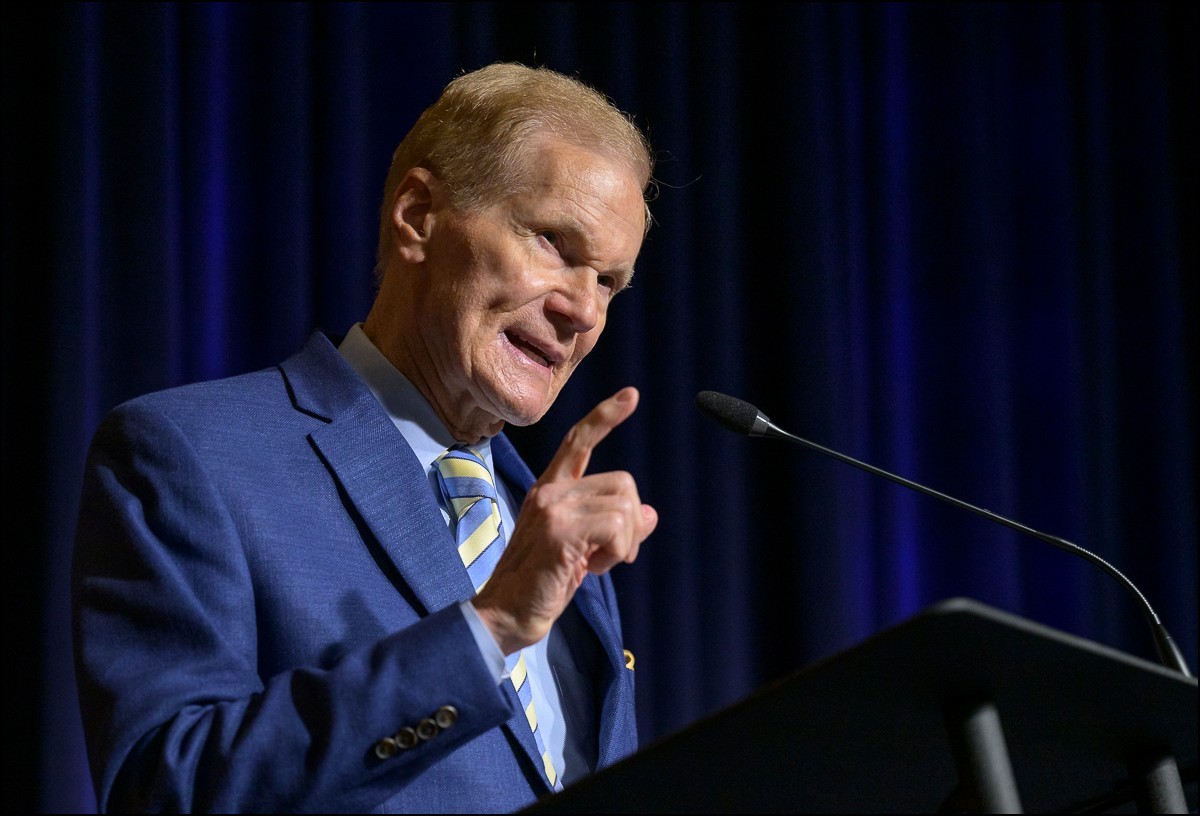
The NASA Disasters Response Coordination System (DRCS) officially launched on June 13, 2024, during a ceremony at NASA Headquarters with Administrator Bill Nelson as the keynote speaker. The DRCS is a revamped, one-NASA approach in how the agency responds to natural hazards and disasters domestically and internationally to support partners and stakeholders. The DRCS will be organized by the Program Office located at NASA’s Langley Research Center (LaRC.) NASA Marshall and Earth Science Branch Disasters team will use subject matter experts to continue supporting the DRCS and events that are responded to by NASA.
Center Response Coordinators Jordan Bell, Ronan Lucey, and Earth Action Associate Disasters Program Manager Lori Schultz represented Marshall at the DRCS launch. Read more about the DRCS launch.
Data Science
NASA Marshall Scientists Highlight Artificial Intelligence Initiatives on Capitol Hill
Dr. Manil Maskey represented NASA’s Interagency Implementation and Advanced Concepts Team (IMPACT) during a discussion about the National Artificial Intelligence Research Resource (NAIRR) Pilot program held on Capitol Hill. The event brought together key members of the House Artificial Intelligence (AI) Caucus, including U.S. Reps. Anna Eshoo, Bill Foster, Haley Stevens, Jim Baird, and Sean Casten. In attendance were several congressional staffers and the director of the National Science Foundation. During the discussion, Maskey highlighted the AI initiatives of NASA’s Science Mission Directorate (SMD) and emphasized the potential benefits of the NAIRR to NASA’s activities. He also showcased the advancements in SMD’s AI foundation model developments. The event served as a platform for sharing insights and fostering collaboration between NASA, other agencies, and key legislative stakeholders on the future of AI research and its applications.
Heliophysics and Planetary
Marshall Planetary Scientist’s Participation at 56th Lunar and Planetary Science Conference 2025
The Lunar and Planetary Science Conference was held in the Woodlands, TX from March 10-15, 2025. Marshall planetary scientist and NASA Postdoctoral Fellow Alka Rani delivered an oral presentation highlighting the evolutionary dynamics of the Martian interior. Rani’s study integrated geochemical analysis, thermoelastic modeling, and seismic data to uncover mantle processes and the spatiotemporal evolution of Martian volcanism. The presentation, “Constraining the Magmatic Evolution of the Elysium Volcanic Province, Mars” was delivered in person. Rani also contributed to two additional posters: “Mission Concept LOOKING GLASS: Exploring Titan as Earth’s Dark Mirror” and “Characterizing Hemispheric-Scale Geologic Processes with Martian Chemical Provinces.” Additionally, Rani served as a moderator for the session “Volcanic Exploration of the Solar System” on Mar. 13, 2025.
Marshall Scientist Presents at the 2025 Solar Dynamics Observatory Science Workshop
Marshall Heliophysicist Amy Winebarger presented at the 2025 Solar Dynamics Observatory (SDO) Science Workshop titled “Using AIA Emission Measure Inversion Failures to Track Interesting Flare Physics.” Fellow Marshall heliophysicist Alphonse Sterling presented “How Small-scale Jet-like Solar Events from Miniature Flux Rope Eruptions Might Produce the Solar Wind.” The meeting celebrated 15 years of SDO science, and included workshops on extreme ultraviolet data calibration, satellite data coalignment, and the SDO foundational model, as well as a working group on vector magnetic field measurements.
Presentation on Large Solar Eruptions Given at Superstorms Workshop
Dr. Alphonse Sterling of NASA’s Marshall Space Flight Center’s Heliophysics and Planetary Science Branch presented at the May 2024 Solar & Geospace Superstorm Workshop at the Johns Hopkins University Applied Physics Laboratory (APL) in Laurel, Maryland. The presentation was entitled “Examining the Early Onset of Selected Large Solar Eruptions During the 2024 May Superstorm Episode.” The workshop focused on the physical processes on the Sun and in the heliosphere that resulted in the low latitude auroral displays visible in various locations around the U.S. including Huntsville, Alabama – where they are not often seen. The workshop was attended by researchers in various disciplines that were impacted by the events, including solar, heliosphere, space weather, magnetosphere, thermosphere, and ionospheric physics.
Marshall Scientist is Keynote Speaker at Lunar Plasma International Network Workshop in Sweden
Dr. Heidi Haviland of NASA’s Marshall Space Flight Center’s Heliophysics and Planetary Science Branch was invited to provide the keynote presentation at the Lunar Plasma International Network Workshop (LuPIN-2) on induced lunar magnetism and its interaction with plasma. In her speech, Haviland discussed the Lunar Vehicle Active Charge Control System (LVACCS) instrument development effort led by Dr. Omar Leon of the University of Michigan and Dr. Linda Krause of Marshall’s Heliophysics and Planetary Science Branch. The meeting was held Sept. 23-27, 2024 at the Hotel Storforsen in Vidsel, Sweden. The conference was particularly interested in the interdisciplinary aspect of lunar plasma science and building an international network to advocate for future lunar plasma science. Made up of 30 participants, the group reviewed limitations of existing observations and analyses, noted open questions in the field, and documented additional measurements for future missions to contribute. Learn more on the conference’s website.



